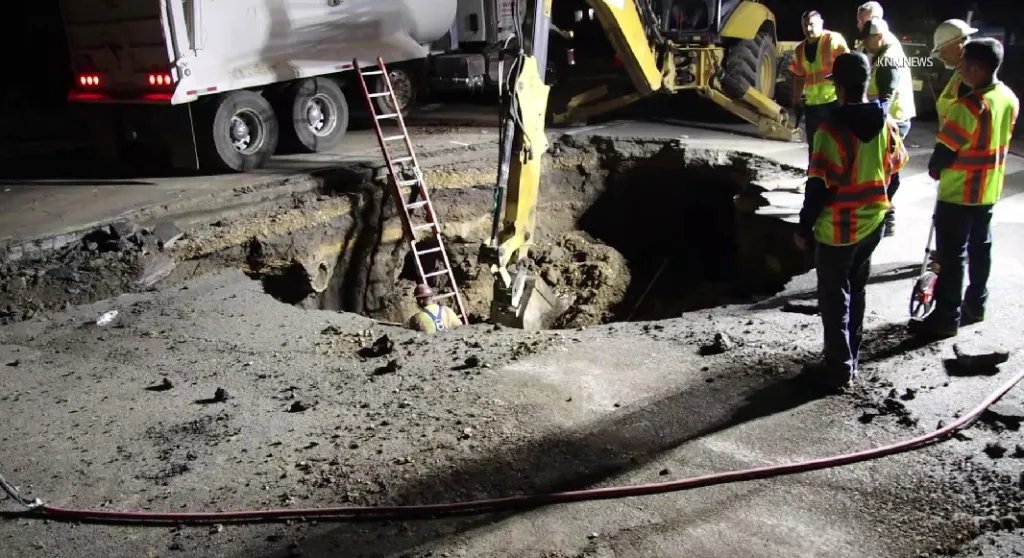Sinkhole in Orange: A Deep Dive into Urban Infrastructure Vulnerabilities
As dawn broke over Orange, California, on October 5, a peculiar scene unfolded. A freshly minted sinkhole, gaping nearly 15 feet deep, had emerged overnight on Meats Avenue at Santiago Boulevard. Traffic was rerouted, and the sound of machinery reverberated against the asphalt as crews worked tirelessly to mend the breach. Such incidents, while often perceived as mere nuisances, illuminate a festering underbelly of urban infrastructure—a narrative that extends well beyond the surface.
What Lies Beneath: The Cause of the Sinkhole
The genesis of the sinkhole is currently under investigation, though initial reports connect it to a water main break. Residents of nearby homes faced water pressure issues, mirroring a cascading effect that rippled through the community. Stephanie Logan, a concerned neighbor, recounted her experience as she monitored her water pressure while preparing for her Saturday routine. “I was a little scared because today’s a hair washing day, and clearly that didn’t happen,” she shared, embodying the mix of anxiety and minor inconvenience that often accompanies such events.
Experts suggest that urban infrastructures increasingly face systemic vulnerabilities exacerbated by climate change and aging materials. Dr. Helena Marks, an associate professor of urban studies at the University of California, stated, “We are witnessing a confluence of aging infrastructure and unpredictable weather patterns, leading to failures like this sinkhole. The irony is that these issues often surface in romanticized areas of urban life where they remain invisible until a crisis erupts.”
The Interconnectedness of Infrastructure
To understand the broader implications of this sinkhole, one must delve into the intricate web of infrastructure dependencies. According to a 2023 study by the National Institute of Urban Development, over 47% of U.S. cities reported significant incidents of collapsed roadways linked to infrastructural deficiencies. Cities globally can glean insights from these ailments:
- Age of Infrastructure: Many water mains and road systems built decades ago are reaching the end of their structural life.
- Climate Resilience: Unexpected weather patterns lead to increased stress on systems not designed to handle such extremes.
- Urban Footprint Growth: Rising populations place additional burdens on existing infrastructures, increasing wear and tear.
The nature of these sinkholes poses pressing questions for city planners and residents alike. As Dr. Samir Ghari, a civil engineering expert from the California Institute of Technology, highlighted, “When a water main breaks, it acts like a destabilizing force, undermining the very foundations of our streets and roads. This is a classic case of one failure leading to another.”
Emergency Response and Community Impact
The response from city officials was swift. Crews labored overnight, following protocols designed for such emergencies. By the morning of October 5, patching work was underway, with officials projecting completion by the end of the day. Yet, as the machines roared, the human impact remained palpable. Residents like Logan faced a temporary disruption that starkly highlighted social considerations intertwined with infrastructure issues.
Residents in the vicinity often felt economically disadvantaged by such emergencies. Local businesses observed an immediate decline in foot traffic, a phenomenon documented in an earlier report by the Urban Economic Research Institute, which found that road failures could reduce patronage by up to 30% in surrounding businesses for days after repairs commence.
A Lesson for the Future
Amidst this disruption lies an opportunity for cities: to reassess, rebuild, and fortify their infrastructures against future crises. Planners are urged to adopt a “whole-system approach,” as Dr. Marks advised. “This approach means recognizing the vulnerabilities across different systems—water, transportation, and even utilities. Cities must invest in resilience.”
Recent technological advancements, including more robust construction materials and real-time monitoring systems, present pathways for mitigation. By incorporating such technologies, cities could, in theory, curb the frequency of sinkholes, providing long-term cost savings and enhanced urban livability.
The Bigger Picture
The sinkhole’s emergence on Meats Avenue is not merely an isolated phenomenon. It is a stark reminder of the pressing realities today’s urban environments face. As cities across the globe grapple with simultaneous challenges of aging infrastructure, climate change, and burgeoning populations, the need for sustainable urban planning has never been more pronounced.
While the orange barricades and construction crews may have temporarily marred the smooth surface of a well-trodden Southern California road, they symbolize something much broader—the ongoing struggle of cities to remain functional, safe, and resilient. While we can repair, pave over, and patch the surface, the foundation of what lies beneath warrants our attention, understanding, and, ultimately, action.





